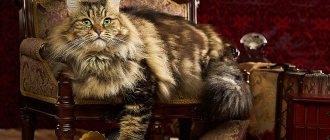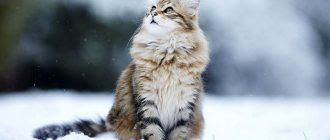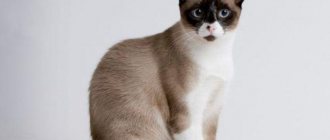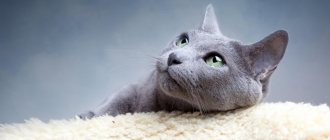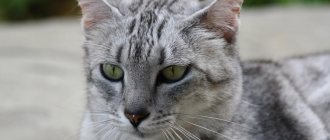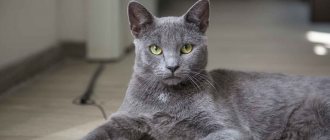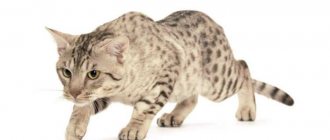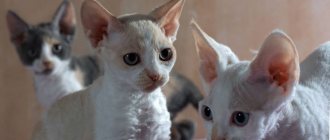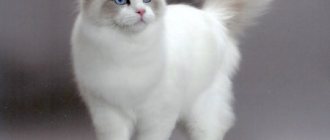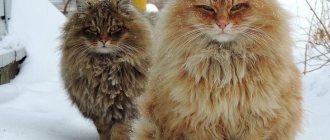This article will provide a complete description of the Siberian red cat. The animal’s character, appearance, size and maintenance rules do not differ from its relatives of other colors. Just like all other Siberians, this purr is endowed with an impressive size, but is graceful and noble. Man did not take part in breeding the breed; the Siberian red cat received all its external and characteristic features from nature - harsh climatic conditions contributed to the development of all the qualities inherent in the breed. If you doubt whether such a pet is suitable for your home, then read the publication where you will learn everything about this beautiful animal. Photos of red Siberian cats are included in the article, and you will be able to appreciate the beauty of the animal.
History of the breed
Siberian cats were first mentioned in the 16th century, but the large animal had a different name - Bukhara. By the way, this name of the breed is still preserved in the Volga region. Then there are records from the 18th century, which say that along the Silk Road, merchants brought a rather expensive, but very large and beautiful cat to the territory of the Russian state.
How did the red Siberian cat appear in Siberia? This is unknown. People from all over our beautiful planet came to explore this harsh region, and any of them could have brought an animal that eventually took root in such harsh conditions.
There is a version that the birthplace of the Siberian breed is Bukhara. But the Bukhara cats known today have an even more interesting coat, which they obtained as a result of crossing with a wild steppe and forest cat. But the fact that the Siberian red cat has wild ancestors is a fact. It was from their wild ancestors that the Siberians received their endurance, hunting skills, strength and some exterior features.
And yet, whatever one may say, the Siberian breed is indigenous. Breeders didn't even have to bother getting a certificate. It was only necessary to improve the gene pool, and crossing with very similar eastern breeds helped with this.
Origin story
The Siberian breed has a long history, but how it originated is not known for certain. Some experts believe that the ancestor of the breed is the Norwegian forest cat, brought to Russia in the 16th century. According to another version, “Siberians” descended from Bukhara cats brought by Central Asian merchants.
Only one thing is known for sure: once on the territory of Siberia, the imported cats adapted to the cold, acquired thick fur, and became dexterous hunters of small game.
Interesting! Siberian cats resemble Pallas' cats in appearance. Therefore, there is an uncommon assumption that representatives of the breed originated from these wild animals.
In the 18th–19th centuries, “Siberians” spread throughout Russia and became the most popular cats of local origin. But breed standards took shape only in the 1980s, when breeding began. Standardizing the breed turned out to be difficult, since in different regions of the country cats had their own external characteristics.
In 1991, the Siberian cat breed was registered by the World Feline Federation. A few years later, the breed has already gained popularity in many countries.
Breed recognition
Despite the fact that the Siberian red cat, a photo of which can be found in the article, became known since the 16th century, the breed was recognized only at the end of the 20th century. The first registered animal of this breed was a cat named Roman, and this event happened already in 1987.
Since the world recognized the Siberian cat, it has become one of the most popular and sought-after breeds. Siberian cats today are not valued as mousecatchers (as was the case before the breed was recognized), but are distributed all over the world as pets, and they certainly no longer need to worry about food.
Description of the Siberian red cat
The breed is spectacular due to its incredibly powerful physique. The cat is muscular, has powerful bones, and the fluffy coat gives even more power to the already not small animal. Despite their enormous size, Siberians are very kind.
Many cat lovers who are allergic to animals may be put off by the presence of a large amount of fur. But, despite the length and thickness of their fur coat, Siberian cats are completely hypoallergenic and do not pose a threat to human health. Grooming is also not particularly difficult, but required.
Standards
Despite the fact that the breed appeared on its own, without the help of breeders, it still has standards that distinguish a true breed (without crossbreeds or defects):
- The main distinguishing feature is its enormous size. If the average weight of a cat is 6 kilograms, then a cat is already 12.
- The muscularity of a cat, but such a physique is formed over three years. Therefore, you should not worry about the purity of the breed if your one-year-old “baby” differs in physique from its relatives.
- The physique is squat, monolithic, and this gives greatness to the breed.
- The incredible strength and agility of cats is due to their body structure. The hind legs are somewhat longer than the front legs, and thus the spine becomes sloping.
- The paws are large and strong, the soles are wide, and there is long and thick hair between the toes - the result of centuries of existence in harsh climatic conditions, the features of a predator.
- The head is spherical and large in size. And at the same time, the animal’s neck is short, but strong and powerful.
- The shape of the muzzle is trapezoidal.
- From its wild ancestors, the Siberian red cat received small, cute tassels on the tips of its ears.
- The eyes are slanting, medium in size, and widely spaced.
- Gorgeous, thick fur, which in cold times saved animals from freezing. Thicker and longer hair is found on the collar, belly, and panties; it can be not only straight, but also curly.
- The aura of a real hunter, which is felt when meeting an animal. This is explained by the piercing gaze and appearance of the cat.
This is the standard of the Siberian red cat. As you can see, there is nothing special that needs to be carefully considered and measured when choosing a kitten.
General characteristics, breed standard
All associations have a common characteristic of the Siberian beauty: a powerful, muscular animal of medium to large size, with a good-natured expression on the face, and semi-long hair. Animals of late development - the final formation of an individual is completed by the age of five.
Description of the external characteristics of the Siberian Cat breed according to the TICA felinological system:
- Head. Triangular with rounded transitions. The forehead is wide, the chin is narrow. The cheeks are large and rounded. The forehead is flat and goes smoothly to the nose.
- Ears. The middle ones, widely spaced, taper to a rounded tip. Slight lean forward. The inside is heavily pubescent, tassels at the ends are welcome.
- Nose. Medium length and width, the transition line from the forehead to the nose is smooth with a slight break. In line with the chin.
- Chin. Well developed, strong, round.
- Mustache. The pods are clearly defined and well developed.
- Eyes. Round shape, round is acceptable. Slightly narrowed towards the outer corner. Any color, regardless of coat color.
- Neck. Powerful, medium length. Visually it appears shorter due to the large fur collar.
- Body. The skeleton is medium, the muscles are well developed. The back is wider than the front. Gives the impression of power, heaviness and strength, especially in cats.
- Paws. The hind ones are longer than the front ones. Length - medium, wide and powerful, pads with edge between fingers, powerful.
- Tail. Shorter than the body length, wide, evenly pubescent, rounded tip.
- Wool. Consists of semi-long main hair - hard and shiny, with water-repellent properties. Double undercoat. Its density depends on the time of year. In warm weather - short, in winter and autumn - voluminous, long, very warm. Characterized by a lush “collar”, wide “pants” on the hind legs, and a plumed tail. Subject to seasonal molting.
- Colors. Numerous and varied - black, blue, red, tortoiseshell, tabby, others.
- Weight. They differ greatly by gender. In females up to six, in males - up to twelve kilograms.
- Crossbreeding is only allowed within the breed.
Disadvantages: poorly formed center hair or undercoat of insufficient length. Poorly developed cheeks, chin, body. Ears that are set too close together are too long and small and low. Short tail, small paws, graceful build, too long neck.
Disqualifying signs:
- excessively even profile or snub nose like the Persians;
- elongated narrow head, creating the impression of lightness;
- small, deep-set eyes;
- poor wool quality, poor health.
Features of color
What is the color of the red Siberian cat? The animal can be monochromatic, and the color varies from rich red with redness to brown. Shades of wool can be golden, cream, silver. Solid color is the rarest.
The color may be monochromatic, but with the presence of stripes that are the same color, but of a darker tone. The most common color of the Siberian cat is red and white. The base is red, and the shirt front and paws are white.
Character
These are playful, active animals that need somewhere to put their energy. By nature, Siberian cats are hunters, but today it is a rare person who will buy an expensive animal for catching mice in a private home. If you live in an apartment and there is no need to clear it of rodents, then you need to buy toys for your pet on which the hunter will practice his skills and satisfy his instincts.
By the way, these are not at all picky animals when it comes to toys. If the cat has driven all its balls and bells under the sofa, it may steal some of the owner's accessories, so if hair ties, cosmetics and other things are missing, look under the furniture.
The character of the Siberian red cat is good-natured and soft. The animals are not vindictive, very loyal to their owner (chooses one from all family members), and smart. They quickly remember the name and will not respond to other words. Accustoming to basic rules of behavior, a scratching post and a tray, will not take much effort and time, since the Siberian breed is endowed with a lively mind!
These huge purrs love to sit by the water, or even take a swim. In order for the animal to have fun and release energy, you can fill the bath with water, put toys in it, the cat will be happy to pull objects out of the water.
If a cat sits somewhere on top, watching life in the house, this is normal. The animal does not hunt, just a craving for heights and observations is in its blood.
Character and habits
The ancestral roots of Siberian cats make themselves known. These taiga beauties are excellent hunters. Their hunting instinct manifests itself to perfection, which allows them to survive in any difficult habitat.
Representatives of this breed easily catch not only small rodents, but also rabbits. The same predatory instinct makes these animals similar in character to dogs. Siberians are happy to bring objects into their mouths. Knowing these features, it will be easier for the owner to decide on a name for his young furry.
The Siberian red cat is very brave. They jealously guard their private space, not letting other animals and people through, notifying the owner of the appearance of strangers. They are absolutely not afraid of dogs, people and all kinds of sounds that disturb other cats, such as sudden noise, honking cars and sirens.
Representatives of this breed are very smart, easy-going and easy to train, starting with accustoming them to the designated toilet area. These are very sensible creatures. They will never go into any place without first making sure it is safe.
Before attempting to remove a rolled toy from under a piece of furniture, they will carefully consider how to do this.
Siberian cats are not capricious. They will play with any object offered, be it a purchased cat toy, a piece of paper or a string. They love to conquer peaks.
You shouldn’t be surprised when you see a pet on a wardrobe, refrigerator or on a tall tree, since such feats are absolutely normal for them. These pets are tolerant of people and behave tactfully with them.
They are very gentle and understanding creatures. They will not constantly demand attention to be picked up, but they will never leave their owner in trouble when he is sick or sad. And at the same time, these cats will not adapt to their owners, because they consider themselves the owners.
The Siberian pet will maintain friendship with members of the household only if they treat it with due respect.
Relationships with other animals and children
A person planning to get a large pet will always assess the possible risks and dangers for children. The Siberian cat is a large hunter, has sharp teeth and claws, powerful paws, strength, and agility. But all this is just to hunt for food. These animals are completely devoid of aggression, and they have no instinct to hunt children under seven years of age. For a child, a cat will become a friend, a nanny, and sometimes even allow you to drag itself by the tail, but in your arms - as much as you like!
As for the other cats, they will become rivals. If you already have a cat and want to get a Siberian, then you can safely take it, the kitten will get used to the other animal and will consider it its parent. If you want to place a cat with an already adult Siberian, you will have to work hard to promote their friendship. Most likely, the second cat will live all its life on a bird's rights, receiving from the owner both for business and just like that!
As for dogs, Siberian cats are completely indifferent to them. You can get a kitten if you have a dog, and a puppy if you have an adult Siberian cat in the house.
From reviews of Siberian owners
The happy owners of these luxurious creatures share their joy and talk about their personal experiences with them. Their ability to easily adapt to new conditions is noted, in particular when they take into the house not a small kitten, but an adult. They talk about friendliness and playfulness.
For example, when a Siberian cat gets bored, he can show resourcefulness to involve the owner in the game - find some toy lying around, bring it closer to the owner and move it towards him with his paw, while looking at him affectionately and slyly.
There are also critical remarks about the breed, saying that the pet has long been an adult, but when playing it still does not remove its claws, and all household members walk around wounded, it is vindictive, and if you touch it while passing, it will soon attack from around the corner.
To this we can answer that, most likely, the owners themselves are to blame, they spoiled the baby, allowed him to scratch, and did not have time to look back at how he grew up. Now this is a familiar form of play for him. And, perhaps, it’s not a matter of rancor, it’s just that the cat, when he was hurt, thought that he was being flirted with, and simply supported the game.
And there are also interesting oddities when a Siberian cat is friends with the male half of the family, for example with the owner and his sons, but only tolerates the female half, for example his wife and mother-in-law, for which the owner respects him and considers him a real man.
Care
During molting, cats with luxurious fur coats need to be brushed every day, and this lasts for almost two weeks. A great option would be to use a powder brush. The rest of the time, you need to scratch the handsome man twice a week, and for this you will need a wooden or metal comb. On other days, the cat will handle the fur just fine.
The need for walking is the same as for dogs. Representatives of the Siberian cat breed (whether they are red, black or white) love to walk, and this desire does not disappear with the onset of cold weather. If you live in the private sector, then ensure safe walks so that the animal does not end up under a car, in the teeth of dogs or in the hands of unscrupulous people. While living in an apartment, you can take your pet for a walk by purchasing a beautiful harness.
As for bathing, it will be required only in case of severe contamination, when the animal cannot cope on its own. There will be no difficulties when swimming, since the Siberian breed is not afraid and even loves water. There is a rule here: never wash your animal with your own or your dog's shampoo. You will need to buy a specialized one for cats with long and thick hair.
Don't forget to clean your ears. Teeth also need care, this will prevent the formation of stone.
You won't have to trim your claws if you provide your animal with a good, comfortable scratching post. In addition to the usual rag scratching post, you can put a wooden board, the huge Siberian cat will happily spend time with this device.
We must not forget about the need for personal space. A cat sometimes needs to hide, retire, and relax, and for this it is better to put up a cat house; it is much more comfortable in it than under the bed.
If living and feeding conditions are good, the animal will live a long life - up to 20 years!
Summary about ginger Siberian cats
The broad Siberian soul lurks in the strong bodies of these magnificent animals. The friendly and sociable creature has retained many of the characteristics of its wild predecessors: a passion for hunting and natural vigilance and attentiveness.
Legends are made about the intellectual abilities of Siberian women. They do not need to be taught various tricks using training techniques, since these cats independently, looking closely at human behavior, figure out what is required of them.
Representatives of this breed are excellent companions and companions, capable of maintaining self-esteem. Although they love to run free, they are strongly attached to the hearth and home and are reminiscent of dogs. They have virtually no fear.
Things that frighten other cats only entertain the Siberian breed. These pets are taciturn and do not speak unless absolutely necessary. They are in excellent health and have no genetic diseases.
Nutrition
Siberian red cat kittens need to be fed 6 times a day for the first three months of life. Next, the animal will eat 2-3 times a day. Provide food with essential vitamins and proteins.
The ideal choice would be to feed natural foods. Siberian cats are not picky eaters, but they love variety; nutrition will not be a problem. The main thing in the diet is at least 60 percent of meat ingredients (pulp, sinews, offal). You can give fish, but not more than once a week, but only sea fish and without bones (preferably boiled). Vegetables and cereals are an essential part of the diet.
If you choose ready-made food, it should be premium. Do not feed only dry food, dilute the diet with liquid food and high-quality canned cat food.
Castration and sterilization
Castration involves the complete removal of the reproductive organs with the cessation of hormonal function. Sterilization is carried out to prevent the birth of offspring. From the point of view of the animal's future life, castration is considered a more humane operation. All behavioral changes associated with hormonal changes in the body cease. During sterilization, some organs remain, and the risk of their neoplasms and diseases is high.
Castration of cats and female cats is carried out at any age throughout the year, but it is not recommended in the summer. This is because at high temperatures the risk of poor wound healing is greater due to the rapid proliferation of bacteria.
You also need to take into account the fact that males and females tolerate intervention more easily at the age of 6-7 months, and in adulthood complications arise much more often. Among them, bleeding is common; systemic infection or prolapse of intestinal loops are less common.
Rehabilitation
After surgery, the animal needs care. The speed of recovery and the condition of the cat depends on the correctness of the owner’s actions. For the intervention, general anesthesia is used. An hour after the operation, the pet is in the clinic under observation. This makes it possible to make sure that everything is happening within normal limits and complications will not arise.
You should leave the contact information of the veterinarian who operated on the animal and call him back in case of emergency. The cat is transported in a carrier designed for this purpose with a disposable or flannel diaper on the bottom. Cover with another diaper on top, if there is a heating pad, then it can be applied from the back.
A car or taxi is used to transport the animal. Upon arrival home, the animal is placed on a bedding and a heating pad is placed. If it's winter outside, you can place the cat near the radiator, but avoid drafts.
Such measures will help to avoid viral and bacterial infections, which can cause harm after surgery. A bowl of water should be placed next to the cat, as after anesthesia his thirst increases. After anesthesia, there may be a very low temperature, which returns to normal within 24 hours. The first feeding occurs after 20 hours, but if the animal does not want to eat, then you should not force it.
Sutures should be treated with hydrogen peroxide and brilliant green 1-2 times a day, and Levomekol ointment for better healing. It is recommended to use a special collar to prevent the animal from paying too much attention to the seams. If surgery is performed in the summer, a course of antibiotic prophylaxis may be necessary.
If your pet's condition worsens sharply, you should immediately contact a veterinarian.
Kittens
Reproductive capacity in Siberians lasts up to 18 years, and there can be up to nine kittens in a litter:
- Kittens are born weighing an average of 100 grams.
- By two months, the baby should weigh an average of 2-3 kilograms.
- By six months the weight can reach six kilograms.
- By the age of one year the weight reaches 6 kilograms. Next comes weight gain; the average weight of adult cats and female cats has already been written about.
Choosing a kitten
As for the price, you can buy a kitten from amateurs for 1000 rubles. But kittens from the nursery are much more expensive, and their price in Moscow averages 20,000 rubles (depending on pedigree, gender, color, age, training). If you decide to save money (and this is normal if you buy an animal for the soul, and not for an exhibition) and buy a kitten from ordinary people, then first evaluate the parents. The kitten itself is easy to distinguish from an ordinary one: by size (weight by month is listed above), standards, fur coat (a fluffy collar and pants are required).
You can pick up a baby from a mother cat from the age of three months. At this time, the animal is already eating on its own, easily accustomed to the tray and new place of residence.
Buy a Siberian cat – tips and tricks
The domestic breed is very popular among cat lovers, both at home and abroad, so purchasing a Siberian kitten is not difficult. But how to choose the right pet?
What to pay attention to
There are several rules that help you choose the best baby from the litter, regardless of its breed:
- a mother cat, despite all the worries and troubles, should look well-groomed;
- a healthy kitten is a cheerful, inquisitive baby, clean, active, well groomed, with clean eyes and ears;
- the smallest kitten of the litter, the “last one”, is usually not in good health, it is smaller and weaker than the others;
- when there is a pedigree, it must be carefully studied, especially if the pet is required for further breeding and participation in exhibitions;
- a kitten for a subsequent show career must have a standard color - kittens with fur of an unusual color not specified in the standard are deprived of this opportunity;
- It is best to take a baby at 2.5-3 months of age - he is already ready to move and be separated from his mother, and has also acquired all the knowledge necessary for independent living.
It is worth looking especially closely at white blue-eyed Siberian kittens. They often have congenital deafness.
Siberian cat price
The cost of babies depends on various factors: the presence or absence of documents, title of parents, color, gender, exterior:
- a kitten that does not have a pedigree can be purchased for 2000-3000 rubles;
- a purebred baby without documents, with minor flaws, will cost from 5,000 rubles;
- for a purebred pet with a pedigree and good characteristics you will have to pay at least 10,000 rubles, and even more for an elite baby.
Nurseries
There will be no problems with purchasing a purebred Siberian kitten; there are a large number of nurseries operating in Russia that breed cats of this domestic breed. In Moscow alone there are more than 2 dozen of them:
- Nursery "Adagio" (https://www.adagiocat.ru/kont.htm);
- Nursery "Atlas Grand" (https://atlasgrand.ru/ru/contacts);
- Cattery of Siberian and Neva masquerade cats “Masquerade Star” (https://mascarad-star.ru).
